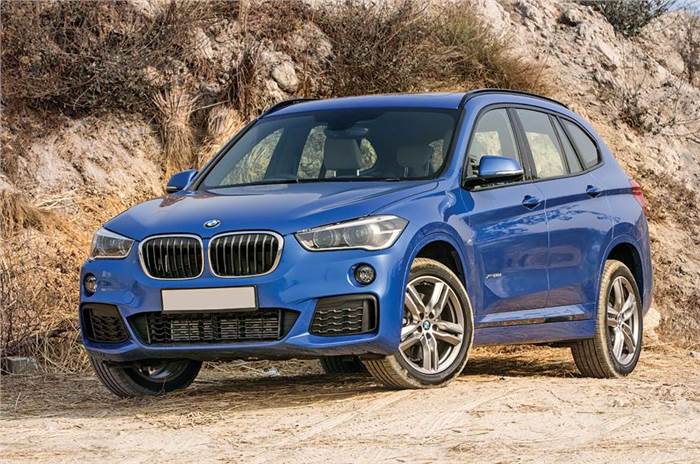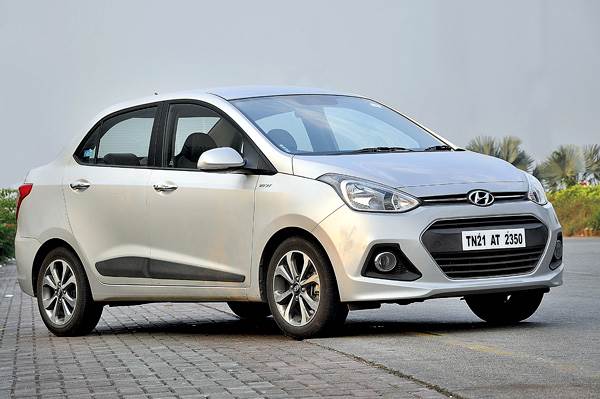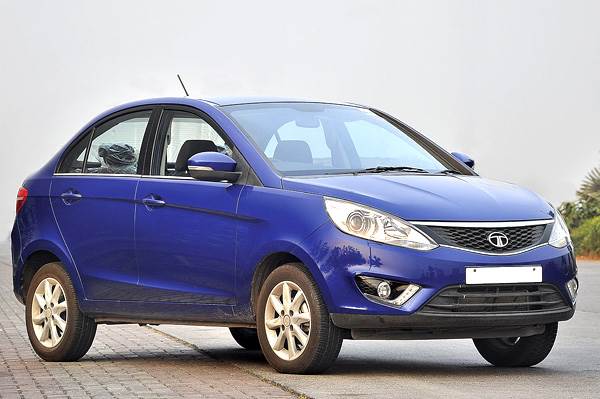What’s new?
The last time these two cars went head to head, the Maruti Dzire and Honda Amaze were there too, but that time we were comparing petrol engines – and Tata’s new turbocharged ‘Revotron’ petrol motor, sadly, wasn’t enough to win that battle. This time, however, we’ve got our hands on what is traditionally the most popular version of such cars – a good old diesel with a manual gearbox. So naturally, we’ve brought back our previous winner in the diesel manual compact sedan segment – the Hyundai Xcent. Is the simplest version of the Tata Zest the one you should go for, and is it good enough to beat the best?
On the looks front, some will like the Tata’s bolder, more extrovert styling, with its big headlamps, chunky wheel arches and high-riding stance, while some might not appreciate the obvious resemblance to the old Tata Vista. The boot also looks a bit short and stubby compared to the Xcent’s more neatly integrated one, which gives the Hyundai better proportions, akin to a conventional mid-size sedan. The Xcent’s overall exterior design is neat, but next to the Zest, some could argue that it looks a little bland, particularly from the rear, and definitely half a size smaller.
What are they like inside?
The Zest’s interior is easily the best effort from Tata Motors yet. The design is modern and stylish, with a good combination of beige, grey and glossy black plastics. We particularly like the dials, with their crisp jewelled effect and the neat and informative digital trip computer nestled within them. The integrated touchscreen audio system is also very well made, but the screen itself is hard to read in bright sunlight – a shame since it holds so many functions.
Quality levels are again a huge step up for Tata, but still not as good as the Xcent, which uses better quality plastics all round and generally feels better screwed together. The Tata also scores poorly on in-cabin storage, with just one small cup holder, a tiny cubby hole beneath the gear lever and very small door pockets. It does, however, have a nice tray under the front passenger seat.

As we mentioned earlier, the Xcent has a high-quality cabin, and though it doesn’t look as flashy as the Zest’s, it is simple and logically laid out; we do wish there was a bit more flair to the design, actually. Here too, the colour scheme is beige and black, and it immediately fares better on practicality with more cup holders and cubby holes, including a handy, closable one just behind the gearlever.

The Zest, however, claws back an advantage with the front seats, which are large, comfortable and supportive. The Xcent’s, in comparison, are a little more firmly cushioned, with non-adjustable headrests, and the fit may be a little too snug for wider frames. Move to the back and both cars offer pretty generous legroom for what are essentially still compact cars. Here too, however, the Zest gives you a slightly better experience. Not only are the cabin and the rear bench considerably wider than the Xcent’s, making it better suited for three, the larger windows also give a better sense of space. Again, we find the softer cushioning of the Tata to be better over long distances than the Hyundai’s, and the Xcent’s backrest is a little too reclined. The Xcent does at least get a rear AC vent and rear central arm rest, which the Zest does not. At 407 litres versus 360 litres, the Hyundai has the bigger boot too, and it’s also better shaped to accommodate larger bags, with a lower loading lip as well.
The engine in the Zest needs no real introduction. It’s Tata’s version of the 89bhp Fiat Multijet engine that you’ll find in a number of cars on sale in India, from the Fiat Punto to the Maruti Ertiga, and of course, the old Tata Manza. While we have seen it in action in the Zest before, that car was equipped with the AMT automatic gearbox, so how does it perform with a conventional manual gearbox? The short answer is familiar, but slightly improved. While this engine has been known to suffer from a lot of turbocharger lag, it seems to be much better contained in this car. As before, however, this motor has a lot of thrust at middle revs, and pulls quite strongly towards its redline as well.

Even just going by the numbers, the Xcent is at a disadvantage here. Its 1.1-litre, three-cylinder diesel motor produces just 71bhp and 18.4kgm of pulling power (the Zest’s engine produces 89bhp and 20.4kgm in comparison). This is evident in the performance figures, where
the Xcent takes a lazy 18.61 seconds to reach 100kph from rest, while the Zest manages it in a more respectable 14.78sec; nearly four seconds quicker.

In isolation, it might seem like the Hyundai has adequate power for most situations, but in truth, you will find yourself shifting gears more often in order to keep the engine in the meat of its powerband; the only place where the thrust feels sufficient. However, we will say that Hyundai has
tuned the motor to be very easy to drive. Unlike the Zest, whose turbocharger suddenly delivers a serious punch at around 2,000rpm, there is hardly any ‘step’ in the Xcent’s power delivery, which comes in one continuous, smooth surge. The power, however, all but disappears at about 3,800rpm, so it’s best to change gears early to try and keep the engine in its mid range. While it has sufficient response at low speeds, it feels a little out of breath on the highway.
Speaking of changing gears, both the cars use five-speed manual gearboxes, and, of the two, the Hyundai’s does feel lighter and smoother to use. The thing is, however, the Zest’s gearbox is not too far behind – it’s light and smooth, but perhaps not quite as easy to slot in gears as the Hyundai’s.
Ride and handling
Here too is an area where Tata has made huge strides. The Zest has a superbly honed balance between comfort and handling ability. Its ride, though a little stiffer than the petrol version, has a nice soft edge over sharp bumps and though you can sense a bit of firmness, it doesn’t toss you around over a rough patch of road. It’s also very stable at higher speeds, which makes it great out on the highway, though the light steering does rob it of some confidence at these speeds. The tall suspension (which gives it great ground clearance) means the car rolls around a bit too much through corners as well.
Mind you, the Xcent’s steering, though better than many other Hyundai cars, feels too inconsistent in its weight and feel to be truly enjoyable, but like the Zest’s, it’s light and works well in slow city traffic. While we also find most Hyundai cars’ suspensions to be too soft, the Xcent’s is quite stiff, which means it tends to crash over sharper bumps where the Zest simply glides over them. It is at least very stable out on the highway, and over smooth road undulations, you won’t get tossed around in your seat. All in all, the Xcent’s suspension is perfectly acceptable in its own right, but the Zest’s is simply much better.
Buying & owning
These two fully loaded cars are quite closely matched on price, with just Rs 43,000 between them. The Zest Quadrajet XT costs Rs 7.04 lakh (ex-showroom, Delhi), while the Xcent CRDi SX (O) costs Rs 7.47 lakh.
On the warranty front, Tata will give you a generous three-year/1,00,000km standard warranty on the Zest, while Hyundai’s two-year/unlimited km warranty is pretty much par for the course.
While we weren’t able to test this version of the Zest for fuel efficiency, its ARAI-certified claimed figure is a decent 21.1kpl overall. The Xcent’s ARAI claimed figure is just a little better at 24kpl, which makes sense, given the Hyundai’s lighter weight.
It must be kept in mind, however, that these claimed figures come from a laboratory. They don’t take into consideration variable factors like traffic, road conditions, pollution and weather, and so, the real-world figures will be more conservative than these.
Equipment & safety
While the diesel auto Zest comes only in a lower-spec XMA trim, it’s good you can get the manual-gearbox diesel in fully loaded XT trim. This means it is the only car in this class to even come close to the Xcent’s long equipment list. There are class firsts, like the touchscreen system and LED running lights, and you also get auto climate control, ABS and two airbags. The touchscreen is connected to an excellent-sounding, eight- speaker audio system, which has Bluetooth (streaming and phone), USB, aux and SD card input; no CD player though. It also has a visual aid for the rear parking sensors, but there’s no camera. Finally, the Zest XT also gets voice commands, but we found them too few and specific to be of any real use while driving; Tata says they could be upgraded at a later stage.
The Xcent SX (O), while missing out a few of the Zest’s new features – like the touchscreen and LEDs – has others that seem to offer more practical benefits. There’s a rear-view camera, keyless entry and go, electric folding mirrors, a cooled glovebox and rear AC vents, for example, and of course, a CD player. It too gets two airbags and ABS, but it is missing speed-sensitive door locks and a real-time fuel-efficiency computer – both of which the Tata gets.
Verdict
The Xcent is a superb compact sedan by any measure, and betters the Zest in a number of areas. The cabin has a higher-quality feel, there are more storage spaces in here, and the boot is usably big. And while both cars have a lot of equipment, we feel the Xcent gives you more useful features. It’s just that it loses out to the Zest in some very key areas. The Tata sedan’s ride quality is just superb, the cabin is wider, the big windows make it feel more spacious, and the seats are more comfortable too. When comparing petrol engines, Hyundai’s Kappa2 motor bested Tata’s Revotron; but with diesels, it’s the other way around. While sufficient for city use, the Xcent’s diesel engine isn’t great for highway cruising, and that’s something that diesel car buyers with high-mileage usage will prefer. Another thing they will prefer is value, and with its slightly lower price tag and big-car dimensions, the Zest delivers that better than the decidedly ‘compact’ Xcent. It’s for these reasons that, in this comparison of diesel cars with manual gearboxes, the Tata edges ahead of the Hyundai.






Comments
Member Login
Personal Details
No comments yet. Be the first to comment.